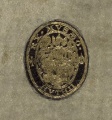Provenance
Provenance is the record of ownership of an object. Provenance can be established through external records, such as sales receipts and booksellers' ledgers, and through internal marks and additions, such as ownership inscriptions and bookplates. Distinctions are often made in provenance studies between private owners and commercial dealers; this is not the case in Folger record keeping. All persons or entities who have had custody of an item, even if temporary, and even if we do not know their name, are considered "former owners" in Folger catalog records.
Types of evidence for establishing Provenance
External
Internal
Signatures
Bookplates
Bookplates come in many sizes and materials, but are commonly made of paper and pasted onto the front pastedown or flyleaves of the book. The Folger's own bookplate, which features Shakespeare's coat of arms, is often tipped to the back pastedown to avoid obscuring earlier provenance information.
The term "Ex Libris," often found on bookplates, translates as "From the library of...".

